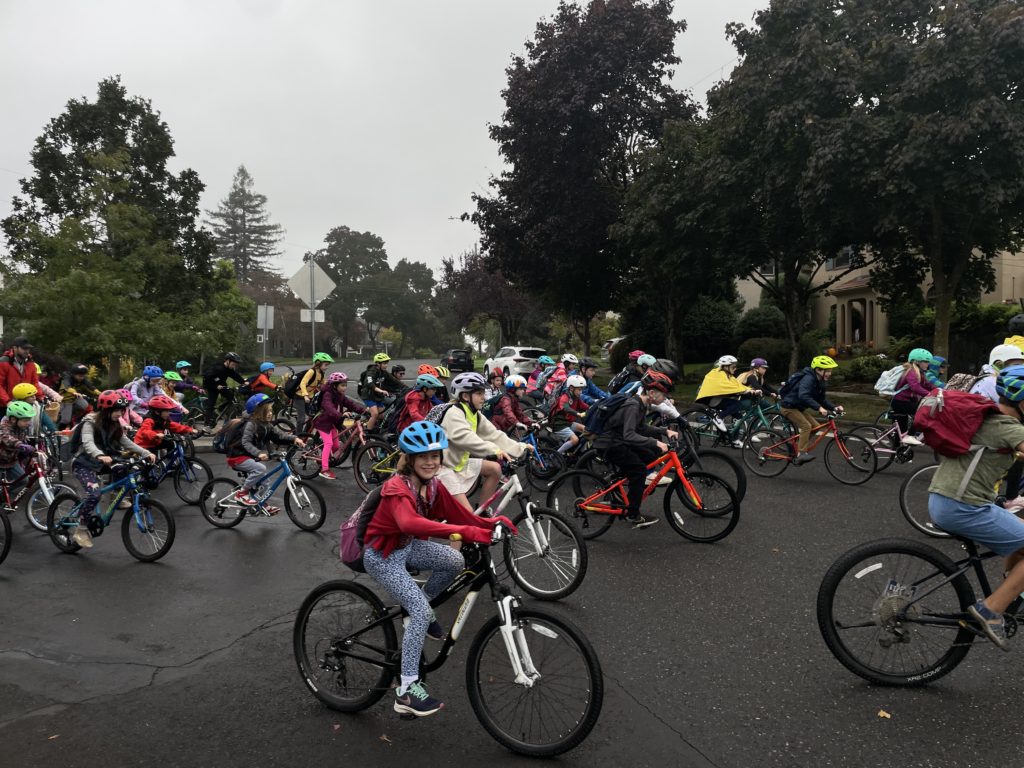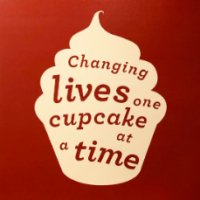
The Alameda neighborhood is usually drowsy at 8:15 in the morning. Most commuters have left for work, leaving the streets largely empty, but the sidewalks still flow with groups of yawning students trudging to class. But on Wednesday mornings, the blocks between Wilshire Park and Alameda Elementary School are transformed. Residents line Klickitat St. with pots, pans and cowbells, cheering for the hordes of children ages five to 10 speeding by on bikes. Kids walking to school sprint down the sidewalks, racing the crowd. The students are accompanied by adults on two-wheelers of their own, some of whom have speakers blasting music from Imagine Dragons to Ozzy Osbourne.
“It kind of feels like being part of a parade,” says Sarah Wexler, an Alameda parent.
The Alameda Bike Bus was started on April 22, 2022, by Alameda Elementary School Physical Education teacher Sam Balto. A bike bus is an alternative to a school bus: Students meet at a designated time and place before school, but, instead of boarding a vehicle, they join parent and teacher volunteers to follow a bike route to campus.
“The year we were back from the pandemic, I saw a video of a bike bus in Barcelona, Spain, on Twitter (now named X) and was like, ‘Oh, I gotta try this.’ And so we did a bike bus for Earth Day. It was a huge success, and we’ve continued to do it every week since,” says Balto.
Every Wednesday morning, a hoard of kids on bikes meet up with Balto and a few other parents at Wilshire Park, while another troop meets on 53rd and Klickitat. The group takes Klickitat all the way to Alameda Elementary, with more students periodically joining the bus along its route. At Klickitat and Alameda St., the two crowds merge into a single bike bus to arrive at the students’ final destination: the Alameda Elementary bike racks.
“I really like biking with my friends … I’ve been doing (the bike bus) since it started,” says fifth grader June Sniffen, whose father is one of the parent volunteers.
It’s not just bikers that are dedicated to the event: Al and Jenny Spinrad — long-time members of the Alameda neighborhood — knew they wanted to find a way to take part in the bike bus from the beginning. They started the tradition of banging pots and cowbells to cheer on the racing cyclists.
“It seemed like a good way to participate in something that was in our neighborhood that we’re really glad is happening,” says Jenny Spinrad. “And then we thought, well, we’ve got to make noise. And so we happen to have these very noisy things. And so we started making noise.”
Al Spinrad adds, “It’s so fun watching them going by, smiling and yelling. So we wanted to do something and they seem to like it.”
The bike bus has also helped get kids excited about learning again. Eighty-seven percent of public schools across the U.S. have reported that students’ social emotional development has been negatively impacted by the COVID-19 pandemic. Community activities that engage and interest kids are proving to be more crucial than ever.
Balto isn’t the first person to start a bike bus, but what sets his apart is the social media attention it has received. Since 2020, Balto has been posting videos on TikTok, educating viewers on bike buses and how people can start them in their communities. His most popular video from late September — explaining how the bike bus safely crosses busy traffic intersections — received over 285,000 likes. As of Oct. 10, 2023, Balto has over 182,000 followers on TikTok.
“I think what’s been most surprising is … just how emotional people get from the videos. If you read the comments on the Tik-Tok videos, a large percentage … are people talking about how they’re crying watching it,” says Balto. “I really think it goes to show how much we want to see children thrive in our society and how rare that is. And the bike bus (exemplifies) this community thriving and coming together to support children, and it’s really sad and unfortunate that (it) is so rare that it brings people to tears.”
A large part of the enthusiasm and support the Alameda bike bus has received is due to its connection with climate activism. Atalanta Powell, another Alameda parent, says, “Portlanders in general are pretty … environmentally conscientious, and so this is just a really great way to have fun and do something that’s a little bit more environmentally positive for the city.”
Many other educators and parents around Portland, Oregon, have been inspired to start their own bike buses, often adapting them to better fit the specific needs of their communities. Sitton Elementary School, in the St. Johns neighborhood, has been employing a walking school bus to include kids in the area without access to bikes.
The overwhelming support for bike buses has led to legislative action as well: In August 2023, House Bill 3014 (also known as the “Bike Bus Bill”) was passed into Oregon law. The bill allows for schools to reallocate transportation funding from school buses towards things like bike buses, walking school buses and crossing guards upon submitting a plan to the Department of Education.
However, Balto makes it clear that more action is needed to improve Portland’s bike access. When House Bill 3014 was passed, Balto worked with over 20 other educators and bike bus founders to write a letter to Portland Commissioner Mingus Mapps, City of Portland Director Millicent Williams and the Portland Bureau of Transportation. The “Safer School Streets Pilot Letter” introduces a plan to make streets around schools safer for student bikers by employing a variety of tactics to reduce the amount of cars on streets with high bike traffic. The proposed pilot outlines eight tactics the city could immediately implement:
One: Adding diverters to keep cars from streets with high bike traffic.
Two: Reducing the number of cars allowed on neighborhood greenways (streets designated as bike streets, such as Klickitat) from 2,000 vehicles per day down to 500 vehicles per day.
Three: Lowering speed limits on greenways and designated Safe Routes to Schools (SRTS) to 15 miles per hour.
Four: Creating a clear path for streets around schools to close for vehicles during drop-off and pick-up times.
Five: Adding signs to all signals that intersect neighborhood greenways and SRTS that say “No Turn On Red.”
Six: Extending the sidewalk curbs of neighborhood greenways and SRTS to reduce the distance of street crossings and enhance visibility for pedestrians and drivers.
Seven: Installing speed cameras on High Crash Corridors (streets with higher rates of car
accidents, such as 82nd Ave.) near schools.
Eight: Financing a $75,000 program at Portland State University to research the impacts of bike buses and walking school buses on the health and learning outcomes of students, as well as on transportation pollution.
“The bike bus is a call to action to our city leaders to create safe space for children to walk and ride bikes, and to exist in the world (and) on our streets. The Bike Bus Bill was … social infrastructure to support communities to pay them to do these types of initiatives, and now we need the physical infrastructure,” says Balto. “So that’s where we came up with the Safer School Streets Pilot.”
Whatever the future of the pilot letter may be, Portland educators, parents and students alike have demonstrated the necessity of having safe ways to bike to school. The Alameda bike bus isn’t stopping any time soon, and Balto hopes to see bike buses continue to flourish across the city: “If there was a high schooler who wanted to start one, make a map of where you’re gonna go. Be consistent. Make it fun, be inclusive and inviting and you’re gonna have a good time.”





